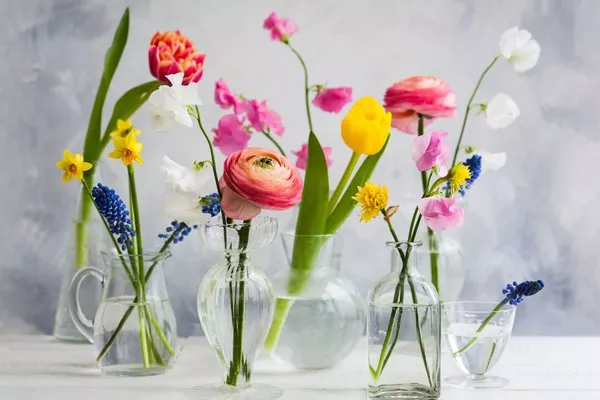Flowers, with their ephemeral beauty, hold a special place in our hearts. Whether it’s a cherished bouquet from a special occasion or blooms from your garden, preserving flowers allows you to extend their life and capture their aesthetic appeal. Glycerin, a versatile and natural substance, has become a popular method for preserving flowers while maintaining their vibrant colors and delicate structures.
Understanding the Science Behind Glycerin Preservation
Glycerin as a Humectant: Glycerin is a clear, odorless liquid that acts as a humectant, meaning it attracts and retains moisture. When used to preserve flowers, glycerin replaces the water content in the plant cells, preventing wilting and decay.
Prolonging the Lifespan: Unlike traditional drying methods that can result in brittle and faded flowers, glycerin preservation maintains the natural suppleness of petals and leaves. It offers a gentle way to extend the lifespan of flowers while preserving their original beauty.
Preserving Color: One of the remarkable benefits of glycerin preservation is its ability to maintain the vibrant colors of flowers. This process is especially valuable for flowers with delicate or vivid hues that may fade with other preservation methods.
Applicability to Various Flowers: Glycerin preservation is suitable for a wide range of flowers, from roses and daisies to hydrangeas and lilies. Its versatility makes it a popular choice for preserving both cut flowers and those growing in the garden.
Choosing the Right Flowers for Glycerin Preservation
Freshness Matters: Select flowers that are at their peak freshness and have not yet reached full bloom. Flowers that are too mature may not absorb glycerin as effectively.
Consider Flower Type: While glycerin works well with many flower varieties, some flowers are more resilient and absorbent than others. Experiment with different types to discover which respond best to glycerin preservation.
Trial and Error: Don’t hesitate to experiment with a small batch of flowers before preserving a larger arrangement. This allows you to fine-tune the process and understand how specific flowers react to glycerin.
Materials Needed for Glycerin Preservation
Glycerin Solution: Create a glycerin solution by combining one part glycerin with two parts water. This ratio ensures the right balance for effective preservation without oversaturation.
Clean Vase or Container: Use a clean and preferably tall vase or container to hold the glycerin solution. The height of the container allows the stems to absorb the glycerin more efficiently.
Sharp Scissors or Pruners: Trim the flower stems at an angle to enhance water absorption. Sharp scissors or pruners ensure clean cuts without damaging the vascular system of the stems.
Water: While glycerin replaces the water in the plant cells, starting the process with fresh water helps maintain the overall health of the flowers.
Steps for Preserving Flowers with Glycerin
Prepare the Glycerin Solution:
In a clean vase or container, mix one part glycerin with two parts water.
Stir the solution well to ensure even distribution.
Trim the Flower Stems:
Using sharp scissors or pruners, trim the stems of the flowers at an angle.
Make the cuts underwater to prevent air from entering the stems, ensuring efficient glycerin absorption.
Submerge Flowers in Glycerin Solution:
Place the trimmed flowers in the glycerin solution.
Ensure that the stems are submerged in the solution, allowing the glycerin to be absorbed through the stem’s vascular system.
Adjust the Solution Level:
As the flowers absorb the glycerin, the solution level may decrease.
Add more glycerin solution as needed to maintain the desired level.
Monitor the Preserving Process:
Glycerin preservation is a gradual process that can take several days to a week.
Monitor the flowers regularly to observe the changes and ensure they are adequately preserved.
Remove Flowers and Rinse:
Once the flowers have absorbed enough glycerin, carefully remove them from the solution.
Rinse the stems under running water to remove excess glycerin.
Air Dry the Flowers:
Allow the preserved flowers to air dry for a few hours.
This step helps the flowers regain their natural texture while retaining the benefits of glycerin preservation.
Arrange the Preserved Flowers:
After drying, arrange the preserved flowers in a vase or create floral arrangements.
Display them in a location away from direct sunlight to prevent fading.
Tips for Successful Glycerin Preservation
Experiment with Color Enhancers: Consider adding a few drops of food coloring to the glycerin solution to enhance or change the color of the flowers. This is especially effective for white flowers.
Combine Glycerin with Drying Agents: To speed up the drying process, consider combining glycerin preservation with drying agents like silica gel. This hybrid method ensures efficient preservation and quick drying.
Test for Readiness: Check the readiness of the flowers by gently squeezing the petals. If they feel supple and flexible, the glycerin preservation is complete.
Maintain Clean Tools: Keep your scissors or pruners clean throughout the process to prevent contamination. Clean tools ensure a smooth and hygienic preservation process.
Avoid Overcrowding: When preserving multiple flowers, avoid overcrowding them in the glycerin solution. Ensure each flower has enough space to absorb glycerin effectively.
Conclusion
Preserving flowers with glycerin is a captivating and rewarding process that allows you to savor the beauty of blooms for an extended period. Whether you’re preserving flowers from a special occasion or creating lasting arrangements from your garden, glycerin offers a gentle and effective method. Follow the step-by-step guide, experiment with different flowers, and immerse yourself in the art of preserving flowers with glycerin. As you witness the vibrant colors and delicate textures preserved in time, you’ll appreciate the enduring elegance that glycerin brings to your cherished floral arrangements.


